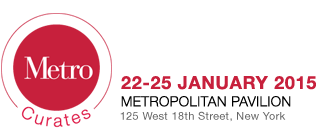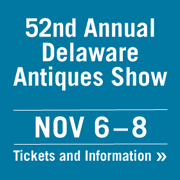 |
Emporiums of the Waggish and Weird |
| http://www.nytimes.com/2015/01/23/arts/design/browsing-at-metro-curates-and-the-ceramics-and-glass-fair.html?_r=1 THIS year, as always, the Winter Antiques Show monopolizes the glamour and the glory, with top-end wares — at top-end prices — making it the trade-fair equivalent of a big Broadway musical. But there is an Off Broadway too, smaller-scale shows that accommodate the wayward, the whimsical and the downright weird. At Metro Curates it is hard to overlook Matthew Dutton’s doglike sculpture, part yeti, part child, at the Stephen Romano Gallery. Clad in synthetic grass, with creepy splayed fingers and toes, it (she?) leans on a beat-up child’s highchair and gazes upward plaintively, as if hoping to be released from a spell. Mr. Dutton, a self-taught artist, lives in Chattanooga, Tenn., where he makes the figurines for Gnome Valley at the nearby Rock City attraction. Metro Curates, formerly known as the Metro Show, is the successor to the American Antiques Show, whose ticket sales and opening-night fund-raiser helped support the American Folk Art Museum. In 2011 the museum, in a state of turmoil, handed over the event to the Art Fair Company of Chicago. It has since taken on a more antic personality, although there is plenty of straight-down-the-middle Americana. M. Finkel and Daughter have exquisite samplers hand-sewn by girls like Mary Robinson, an 11-year-old from Lancaster, Pa., whose two 1808 works on green linsey-woolsey show her precise needlework and command of a graceful, curving line. If that’s not American enough, Jeff R. Bridgman American Antiques can help. Its many American flags include a giant hand-sewn version from the Reconstruction era with 37 six-pointed stars arranged in clusters and a 19th-century silk flag not much larger than a postage stamp, to be worn with a medal or on the lapel. A West Virginia barber shop disgorged one of the fair’s more eye-popping specimens, a 1940s dresser and shelf at the Carl Hammer Gallery. Its drawers bristle with serrated wood strips painted in gaudy colors, making it look a bit like a Technicolor hedgehog. The Tambaran Gallery, devoted primarily to tribal art, has an intricately carved red-and-black Tlingit rattle from the Pacific Northwest. On the back of a fierce-looking raven, a shaman figure exchanges a torrent of vision-inducing fluid, mouth to mouth, with a tiny toad. It is an interesting situation. Two more highlights: an ornate 19th-century bird cage in the shape of a galleon at Marion Harris, and a copper Nepalese guardian figure, circa 1950, that looks like an Easter Island statue crossed with a praying mantis.
|
| http://www.nytimes.com/2015/01/23/arts/design/browsing-at-metro-curates-and-the-ceramics-and-glass-fair.html?_r=1 |
 back to press coverage back to press coverage |
| 2 pm 8th Floor Dialogues | |
| The Unknown Artist In this illustrated presentation, John Foster discusses the .. More  |
| 11 A.M. 8th Floor Dialogues | |
| Art Brut from Japan: The International Context Edward Gomez will discuss the still-young, still-evolving fi.. More  |
 The name "Larsen" is synonymous with 20th century textiles. Ever since Jack Lenor Larsen, Inc. was established in 1952, the influence of its innovative, farseeing founder has permeated the field of interior design. Ranging from filmy casement cloths to plush upholstery, from the formal geometry of complex doubleweave to the freshness of colorful organic prints, Larsen textiles have enhanced walls and floors of large company headquarters, educational institutions, jet planes, and private homes.
The name "Larsen" is synonymous with 20th century textiles. Ever since Jack Lenor Larsen, Inc. was established in 1952, the influence of its innovative, farseeing founder has permeated the field of interior design. Ranging from filmy casement cloths to plush upholstery, from the formal geometry of complex doubleweave to the freshness of colorful organic prints, Larsen textiles have enhanced walls and floors of large company headquarters, educational institutions, jet planes, and private homes.




